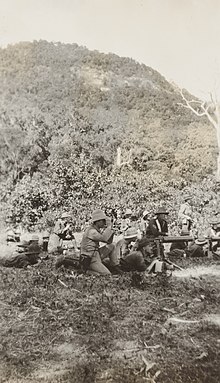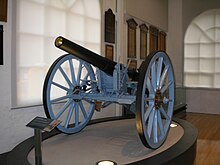
The Battle of Rabaul, also known by the Japanese as Operation R, an instigating action of the New Guinea campaign, was fought on the island of New Britain in the Australian Territory of New Guinea, from 23 January into February 1942. It was a strategically significant defeat of Allied forces by Japan in the Pacific campaign of World War II, with the Japanese invasion force quickly overwhelming the small Australian garrison, the majority of which was either killed or captured. Hostilities on the neighbouring island of New Ireland are usually considered to be part of the same battle. Rabaul was significant because of its proximity to the Japanese territory of the Caroline Islands, site of a major Imperial Japanese Navy base on Truk.
The history of the Australian Army is the culmination of the Australian Army's predecessors and its 120-year modern history. The Army has its origins in the British Army and colonial military forces of the Australian colonies that were formed prior to the Federation of Australia. These were gradually united into federal units between 1899 and 1903; thus forming the beginning of the Australian Army. The colonial forces were combined and formed the basis of the new army, when the Commonwealth of Australia was founded on 1 January 1901. The modern history of the Army began with its founding at the start of the 20th century as the colonial armies were officially united as the Commonwealth Military Forces. In 1916 the title 'Australian Military Forces' was adopted and remained its official name until 1980, after which it became known as the Australian Army.

Major General William Holmes was a senior Australian Army officer during the First World War. He was mortally wounded by a German artillery shell while surveying the ground won at the Battle of Messines.

The 1st Battalion was an infantry battalion of the Australian Army. Although its numerical name was designated during the First World War, the 1st Battalion can trace its lineage back to 1854, when a unit of the Volunteer Rifles was raised in Sydney, New South Wales. This unit has since been redesignated a number of times, but through its links with the units of the colonial NSW defence force, the battalion's history includes services in Sudan and South Africa. During the First World War, the 1st Battalion was raised for overseas service in 1914 as part of the First Australian Imperial Force. Attached to the 1st Brigade, the battalion served in Egypt initially before taking part in the fighting in Gallipoli against the Turks. Later the battalion was sent to the Western Front where it fought in the trenches in France and Belgium as part of the Australian Corps. Following the end of the war the battalion was disbanded in 1919.
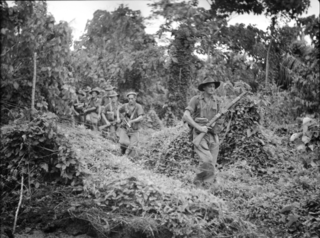
The 19th Battalion was an infantry battalion of the Australian Army. Although the unit's numerical designation was bestowed upon it during World War I, the unit can trace its origins back to 1860 when a Volunteer Rifle corps was raised in South Sydney. During World War I, the 19th Battalion was raised as a unit of the Australian Imperial Force, attached to the 5th Brigade, of the 2nd Division. The unit was formed in 1915 and was first sent to Gallipoli where it fought against the Turks, before being withdrawn from the peninsula and being sent to France in early 1916, where it served in the trenches along the Western Front. Over the next two years the battalion fought in many major battles and won numerous battle honours. In April 1918, it took part in defending against the German Spring Offensive, before the Allies launched their own last-ditch effort as part of the Hundred Days Offensive. The battalion was disbanded in October 1918 due to manpower shortages in the AIF and most of its men were sent to reinforce the other three battalions of the 5th Brigade.

In Australia, the outbreak of World War I was greeted with considerable enthusiasm. Even before Britain declared war on Germany on 4 August 1914, the nation pledged its support alongside other states of the British Empire and almost immediately began preparations to send forces overseas to engage in the conflict. The first campaign that Australians were involved in was in German New Guinea after a hastily raised force known as the Australian Naval and Military Expeditionary Force was dispatched in September 1914 from Australia and seized and held German possessions in the Pacific. At the same time another expeditionary force, initially consisting of 20,000 men and known as the First Australian Imperial Force (AIF), was raised for service overseas.
Brigadier General Edward Fowell Martin, was an Australian accountant, public servant, and a senior Australian Army officer who served in the First World War.
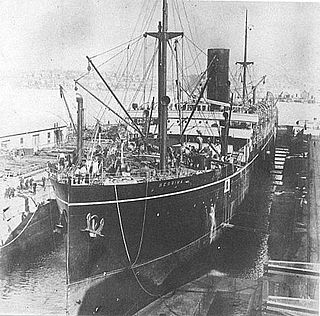
HMAS Berrima was a passenger liner which served in the Royal Australian Navy (RAN) during World War I as an armed merchantman and troop transport. Launched in 1913 as the P&O liner SS Berrima, the ship initially carried immigrants from the United Kingdom to Australia via Cape Town. In August 1914, Berrima was requisitioned for military use, refitted and armed, and commissioned into the RAN as an auxiliary cruiser. The ship transported two battalions of the Australian Naval and Military Expeditionary Force to the German New Guinea colonies in September.
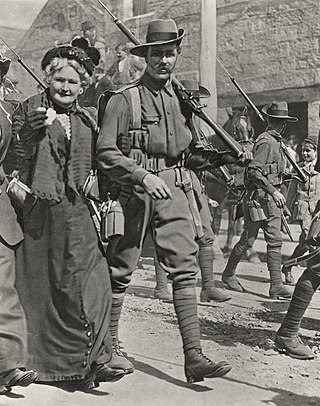
The Battle of Bita Paka was fought south of Kabakaul, on the island of New Britain, and was a part of the invasion and subsequent occupation of German New Guinea by the Australian Naval and Military Expeditionary Force (AN&MEF) shortly after the outbreak of the First World War. Similar to New Zealand's operation against German Samoa in August, the main target of the operation was a strategically important wireless station—one of several used by the German East Asia Squadron—which the Australians believed to be located in the area. The powerful German naval fleet threatened British interests and its elimination was an early priority of the British and Australian governments during the war.
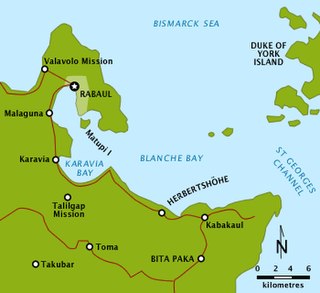
The siege of Toma was a bloodless action during the First World War on the island of New Pomerania between 14 and 17 September 1914 as part of the occupation of German New Guinea by the Australian Naval and Military Expeditionary Force (AN&MEF). Australian forces had been dispatched to seize and destroy German wireless stations in the south-west Pacific because they were used by the German East Asian Cruiser Squadron of Vice-Admiral Maximilian von Spee which threatened merchant shipping in the region. New Zealand provided a similar force for the occupation of German Samoa. Ultimately the German colonial government was forced to surrender after being surrounded, ending the last significant resistance in the territory.

5th Brigade is a brigade of the Australian Army. Originally raised as a militia formation in 1912, the 5th Brigade was re-raised for overseas service in 1915 as part of the Australian Imperial Force during the First World War. The brigade then served during the Gallipoli Campaign and on the Western Front. During the inter-war years, it was re-raised as a part-time formation as part of Citizens Military Force. It undertook garrison duties in Australia during the Second World War, but was not deployed overseas before being disbanded in 1944. Following the war, the brigade was re-raised in 1948 once again and it is currently a Reserve combined arms formation based in New South Wales and forms part of the 2nd Division.
Lieutenant Basil John Blackett was a British World War I flying ace credited with five aerial victories as an observer and rear gunner while serving in the Australian Imperial Force, seconded to the Royal Flying Corps. In late 1918 he resigned his Australian commission to join the Royal Air Force.
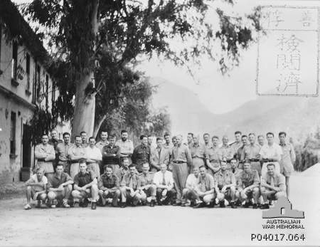
The 2/22nd Battalion was an infantry battalion of the Australian Army. Raised as part of the Second Australian Imperial Force for service during World War II, the battalion formed part of the 23rd Brigade, attached to the 8th Division. It was captured by the Japanese during the Battle of Rabaul in 1942. After being captured, the battalion was not re-raised and a large number of its personnel died in captivity; those that did not were returned to Australia at the end of the war in 1945.

The Wallach brothers were a family of eight boys born to Henry and Mary Wallach of Bondi Beach in Sydney, Australia toward the end of the 19th century. Six of the brothers all saw active service in World War I. The fourth and eighth brothers, Clarrie and Neville were both top-grade rugby union players before the War. They both saw action at Gallipoli, were promoted on the Western Front as Captains, were both recipients of the Military Cross and each fell within a week of each other in France in fighting at the time of the Second Battle of Villers-Bretonneux.

The Australian occupation of German New Guinea was the takeover of the Pacific colony of German New Guinea in September – November 1914 by an expeditionary force from Australia, called the Australian Naval and Military Expeditionary Force.
This is an order of battle listing the Australian and German Empire forces during the Australian occupation of German New Guinea between September and November 1914.

The Australian Army was the largest service in the Australian military during World War I. The First Australian Imperial Force (AIF) was the Army's main expeditionary force and was formed from 15 August 1914 with an initial strength of 20,000 men, following Britain's declaration of war on Germany. Meanwhile, the separate, hastily raised 2,000-man Australian Naval and Military Expeditionary Force (AN&MEF), landed near Rabaul in German New Guinea on 11 September 1914 and obtained the surrender of the German garrison after ten days; it later provided occupation forces for the duration of the war. In addition, small military forces based on the pre-war Permanent Forces and part-time Citizen Forces were maintained in Australia to defend the country from attack.
While Australia was distant from the main theatres of World War I, small military forces were maintained to defend the country from attack throughout the war. German raiders were considered the main threat, though there was also concern about acts of sabotage.

The structure of the Australian Army during World War I included a small force of mostly militia which served in Australia and larger expeditionary forces which were raised for deployment overseas following the outbreak of the conflict in August 1914. The home army consisted of the small regular Permanent Forces, the part-time Citizen Forces, and the Australian Garrison Artillery, which were maintained in Australia to defend the country from attack, while expeditionary forces consisted of the Australian Naval and Military Expeditionary Force (AN&MEF) which occupied German New Guinea from September 1914, and the Australian Imperial Force (AIF) which fought at Gallipoli in 1915, and in the Middle East and on the Western Front in Europe from 1916 to 1918. Following an initial precautionary mobilisation following the outbreak of war, by the end of August 1914 those units of the reserve formations of the home army that had been activated began to stand down. From 1915, only skeleton garrisons were maintained at coastal forts. Meanwhile, as the war continued overseas the AIF sustained heavy losses, and although it expanded considerably during the war, with the voluntary recruitment system unable to replace its casualties by 1918 most of its units were significantly undermanned.
Commander Joseph Arthur Hamilton Beresford was a senior officer in the Royal Australian Navy. Born in Laugharne, Wales, Beresford came to Australia in 1900 on loan from the British Royal Navy. During the early stages of the First World War he commanded the naval brigade attached to the Australian Naval and Military Expeditionary Force (AN&MEF) which captured German New Guinea in September 1914. He was later mentioned in despatches. His only son, Arthur, was killed during the war serving with the 26th Battalion. Beresford later settled in Sydney where he lived until the death of his wife in 1951. He died at the age of 91 in Hobart, Tasmania. He was survived by a grandson and a granddaughter.

